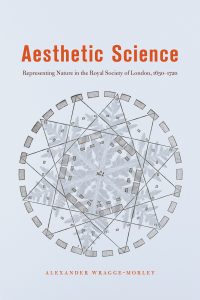5 Questions with Alexander Wragge-Morley, author of “Aesthetic Science: Representing Nature in the Royal Society of London, 1650–1720”
In his new book, Aesthetic Science, Alexander Wragge-Morley explores scientific representation in the early modern period and shows us how vital the role of subjective experience is to the communication of knowledge about nature. It’s a fascinating, groundbreaking reconsideration of the role of aesthetic experience in the history of the empirical sciences, and we sent him a few questions about it.
In Aesthetic Science, you explore the relationship between sensory experience and the production of knowledge. What drew you to the topic? What do you like about it?
I’d say that there’s a lot to like when you think about the relationship between sensory experience and the production of knowledge. To start, the issue is obviously fundamental—and I like fundamental issues. I don’t think you can give a good account of knowledge production unless you think hard about how the senses—with all the feelings they provoke—give us access to the external world. What’s more, that fundamental question allows you to think about the history of science in new ways. By focusing on how the scientists of seventeenth-century England related to sensory experience, I was able to pull a wide range of disciplines together—disciplines that are usually studied separately. In Aesthetic Science, I ended up talking about art, literature, material culture, philosophy, and religion at the same time. For me, that work was immensely rewarding.
The image on the book cover—a rendering of Stonehenge overlaying a snowflake—was your idea. Can you tell us more about the meaning behind the design?
It’s true—the front cover shows a map of Stonehenge by the English architect Inigo Jones (1573–1652) superimposed over a snowflake. The key to unlocking this mysterious image is revealed in Chapter 3, but I’ll give away a few hints here. For scientists like Robert Hooke and Robert Boyle, the natural world was the work of a supremely talented designer—God. In Aesthetic Science, I show that they didn’t just use this idea to defend themselves against suggestions of atheism. They actually practiced a form of science that depended on seeing the world as the product of a designer. Sometimes, they even rejected the evidence of their senses when it didn’t have the beauty they expected from the work of a good designer. I chose the cover image because it reflects this key idea. When Inigo Jones encountered the ruins of Stonehenge, he decided that they must once have been far more perfect. He imposed his sense of design on what he saw. In Chapter 3, you’ll see that a famous scientist did the same thing with snowflakes.
While you were working on the book, what did you learn that surprised you the most?
That’s easy. I was absolutely blown away by Robert Hooke’s suggestion that one of the most beautiful thing he had seen in his entire life was his own urine, frozen and viewed through a microscope. For Hooke, it “was in every particular so transcendent,” that he “judge[d] it almost impossible for humane art to imitate.”
What’s next for you? Are you working on any projects that you’re particularly excited about?
Right now I’m working on a project about the role of feeling in eighteenth-century medicine. I’m looking at medical practitioners and patients who believed that medical expertise depended on having felt exactly the same symptoms as the person now suffering them. I’ve just turned up some really exciting letters between two women discussing their treatment at the hands of the same male physician. One of the women, at least, wasn’t very convinced by the physician’s attempts to claim that he knew exactly what she was feeling.
On top of that, I’ve been working on a project about a blind chemical lecturer called Henry Moyes, who toured both Britain and the United States in the late eighteenth century. I’m fascinated by his attempts to show that he could feel pretty much the same sensations as the sighted people around him. Once again, I’m fascinated by the way people related sensory experience to their capacity for knowledge and community with others.
Best book you’ve read lately?
My quarantine reading was Hilary Mantel’s The Mirror and the Light, the third in her series on Thomas Cromwell. Mantel is a serious writer in the tradition of George Eliot and Virginia Woolf—immensely learned but capable nevertheless of reducing difficult ideas to a simple, terse expression. I also think professional historians can learn a lot from the way she deftly relates fact to imagination.
Alexander Wragge-Morley is a lecturer in the history of science and medicine at Lancaster University, UK.
Aesthetic Science is available now on our website or from other booksellers.
